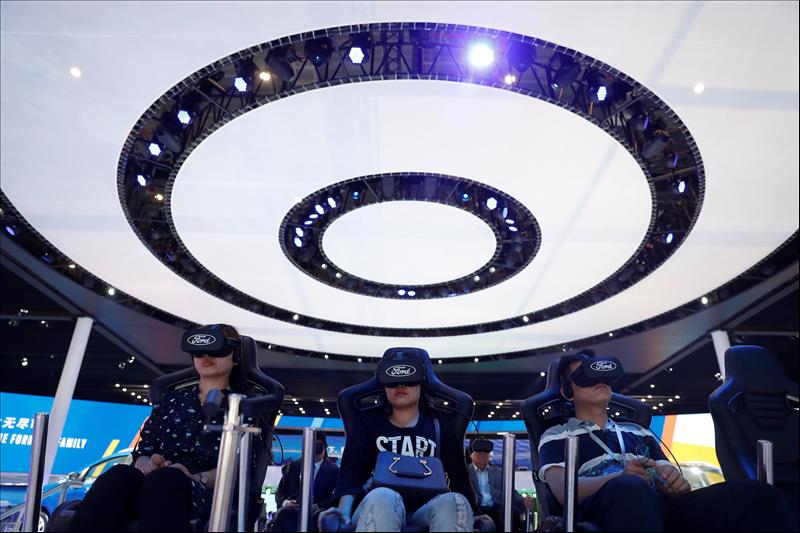
Tourist destinations bet on VR marketing to lure Chinese
The VR industry, still very much in its infancy, is divided across a multitude of young platforms, including HTC's Vive, Facebook's Oculus, Samsung's Gear VR, Sony's PlayStation VR, and Google's Daydream. However, only a few of these – often expensive – platforms are available in the Chinese market, which instead has become dominated by relatively low-tech and platform-independent mobile VR solutions.
According to Canalys, a Singaporean company specializing in technology-market analysis, China accounted for 40% of the VR-headset market in 2016, making it the leading market for VR technologies. On Singles' Day – a festival when young Chinese celebrate being unmarried – last year, Alibaba sold 150,000 pairs of cardboard VR goggles, simple contraptions that can be used with most modern smartphones. In contrast, the VR market in the United States remains dominated by higher-cost alternatives from Sony and Facebook.
The DailyBrief Must-reads from across Asia - directly to your inboxThe low cost of entry and relative success of simple mobile VR solutions in China has made it an interesting frontier for destination marketers, which are faced with increasingly stiff competition for China's high-end tourists. VR marketing is proving a promising way to reach China's young and affluent travelers with – compared with traditional marketing channels – a limited budget. According to a German study on VR's role in tourism marketing, 62% of respondents would like to use virtual reality in their tourism planning, with 13% even willing to pay for the privilege.
Chinese destinations have been among the first to embrace virtual reality as a tourism marketing tool, betting on immersive VR experiences to excite prospective tourists about their destinations. Sanya, the southernmost city on China's Hainan Island – a popular domestic tourist destination – recently launched a WeChat-based VR platform that allows users to explore local sights and scenery in 360 degrees by simply attaching a cheap VR headset to their smartphones. But Sanya is far from alone, as many Chinese destinations are trying to stay in the forefront of marketing innovation to stand out in the highly competitive domestic tourism industry.
However, Chinese consumers are excited about new VR experiences as well, with whole platforms focused exclusively on virtual travel content popping up in China – filled with both private footage and official marketing content. UtoVR, one of many such platforms, serves VR footage of everything from official scenic tours of international tourism destinations to individual tourists' 360-degree recordings of nightlife in Bangkok's red-light districts.
While international destinations may be behind their domestic peers in capturing the imagination of Chinese VR users, VR marketing is becoming an increasingly common sight at international travel trade fairs around the world, including in China.
In Los Angeles, FansTang, a Chinese company specializing in VR content targeting Chinese millennials, was quicker to realize the potential of Los Angeles-focused VR experiences than the local tourism authorities. To satisfy its users' lust for VR content that depicts Los Angeles tourism attractions, the company has been recording 360-degree videos of various landmarks and attractions without any guidance from the local tourism board.
On the other side of the Atlantic, Tourism Ireland has teamed up with China Youth Travel Service to serve Chinese consumers with 360-degree footage of the Wild Atlantic Way, a tourism trail on the west coast of Ireland, hoping to encourage Chinese millennials to experience the scenery by themselves.
Meanwhile, the mainland Chinese government has teamed up with Taiwanese consumer-electronics company HTC to launch the China VR Tourism Cloud Data Service Platform, which will be rolled out in tens of thousands of stores nationwide to let prospective tourists explore different destinations in virtual reality. While details about the clunkily named platform are still scarce, some of China's largest travel agencies have already been signed as partners, including travel agencies primarily serving international destinations.
According to the company, the ambition is to have the system implemented at a majority of China's more than 200,000 offline travel agencies, with the potential of taking VR from a niche marketing tool for reaching tech-savvy consumers to a necessity for staying relevant in the Chinese tourism marketplace in the years to come.
This article was originally published on Jing Travel.
Share Tweet Linkedin Email China Opinion tourism Virtual Reality high technology marketing Millennials Daniel Meesak Excited about the prospects of a more interconnected world, Daniel is passionate about global travel and the opportunities it brings to brands and destinations throughout the world. Prior to joining Jing Daily, Daniel spent significant time in China conducting field research and later joined a consultancy firm focused on global Chinese travel. Coming from a finance background, he puts great emphasis on data and the business of travel.
Legal Disclaimer:
MENAFN provides the
information “as is” without warranty of any kind. We do not accept
any responsibility or liability for the accuracy, content, images,
videos, licenses, completeness, legality, or reliability of the information
contained in this article. If you have any complaints or copyright
issues related to this article, kindly contact the provider above.


















Comments
No comment